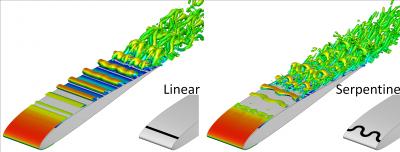Serpentine path to design savings
Plasma can be used to control the flow of fluids, and with recent advances it may now be employed to reduce drag and improve aerodynamic efficiencies for vehicles of all kinds.
The plasma soup of charged particles in an electric field can be used to manipulate fluid flows in increasingly complex ways. Researchers at the University of Florida’s Applied Physics Research Group (APRG) have created a new plasma actuator with a distinctly snake-like form, capable of easily modifying its geometry in an extremely versatile way.
According to Mark Riherd, a doctoral candidate working under Subrata Roy, the founding director of APRG, the “serpentine device will have applications in reducing drag-related fuel costs for an automobile or an aircraft, minimizing the noise generated when flying over populated areas, mixing air-fuel mixtures for lean combustion, and enhancing heat transfer by generating local turbulence.”
In a report published by the Journal of Applied Physics, the team validated the complex, three-dimensional flow structures induced by their plasma actuators, comparing numerical results with recent physical experiments in non-moving air.
Researchers subsequently simulated the effects of the actuators in a non-turbulent boundary layer and over a small aircraft wing. They deemed that further tests are needed, but early results suggest serpentine flow wrangling may improve transportation efficiencies.
“This may result in significant weight and fuel savings for future aircraft and automobiles, improving energy efficiency all around,” Riherd said.
The findings are detailed in this report.









 Print
Print